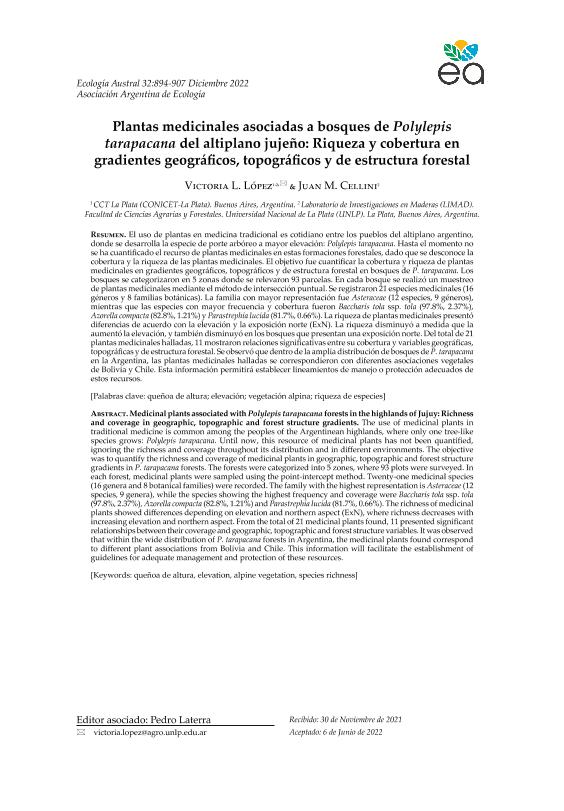Mostrar el registro sencillo del ítem
dc.contributor.author
Lopez, Victoria Lien

dc.contributor.author
Cellini, Juan Manuel

dc.date.available
2023-12-26T09:43:20Z
dc.date.issued
2022-12
dc.identifier.citation
Lopez, Victoria Lien; Cellini, Juan Manuel; Plantas medicinales asociadas a bosques de Polylepis tarapacana del altiplano jujeño: Riqueza y cobertura en gradientes geográficos, topográficos y de estructura forestal; Asociación Argentina de Ecología; Ecología Austral; 32; 3; 12-2022; 894-907
dc.identifier.issn
0327-5477
dc.identifier.uri
http://hdl.handle.net/11336/221284
dc.description.abstract
El uso de plantas en medicina tradicional es cotidiano entre los pueblos del altiplano argentino, donde se desarrolla la especie de porte arbóreo a mayor elevación: Polylepis tarapacana. Hasta el momento no se ha cuantificado el recurso de plantas medicinales en estas formaciones forestales, dado que se desconoce la cobertura y la riqueza de las plantas medicinales. El objetivo fue cuantificar la cobertura y riqueza de plantas medicinales en gradientes geográficos, topográficos y de estructura forestal en bosques de P. tarapacana. Los bosques se categorizaron en 5 zonas donde se relevaron 93 parcelas. En cada bosque se realizó un muestreo de plantas medicinales mediante el método de intersección puntual. Se registraron 21 especies medicinales (16 géneros y 8 familias botánicas). La familia con mayor representación fue Asteraceae (12 especies, 9 géneros), mientras que las especies con mayor frecuencia y cobertura fueron Baccharis tola ssp. tola (97.8%, 2.37%), Azorella compacta (82.8%, 1.21%) y Parastrephia lucida (81.7%, 0.66%). La riqueza de plantas medicinales presentó diferencias de acuerdo con la elevación y la exposición norte (ExN). La riqueza disminuyó a medida que la aumentó la elevación, y también disminuyó en los bosques que presentan una exposición norte. Del total de 21 plantas medicinales halladas, 11 mostraron relaciones significativas entre su cobertura y variables geográficas, topográficas y de estructura forestal. Se observó que dentro de la amplia distribución de bosques de P. tarapacana en la Argentina, las plantas medicinales halladas se correspondieron con diferentes asociaciones vegetales de Bolivia y Chile. Esta información permitirá establecer lineamientos de manejo o protección adecuados de estos recursos.
dc.description.abstract
Medicinal plants associated with Polylepis tarapacana forests in the highlands of Jujuy: Richness and coverage in geographic, topographic and forest structure gradients. The use of medicinal plants in traditional medicine is common among the peoples of the Argentinean highlands, where only one tree-like species grows: Polylepis tarapacana. Until now, this resource of medicinal plants has not been quantified, ignoring the richness and coverage throughout its distribution and in different environments. The objective was to quantify the richness and coverage of medicinal plants in geographic, topographic and forest structure gradients in P. tarapacana forests. The forests were categorized into 5 zones, where 93 plots were surveyed. In each forest, medicinal plants were sampled using the point-intercept method. Twenty-one medicinal species (16 genera and 8 botanical families) were recorded. The family with the highest representation is Asteraceae (12 species, 9 genera), while the species showing the highest frequency and coverage were Baccharis tola ssp. tola (97.8%, 2.37%), Azorella compacta (82.8%, 1.21%) and Parastrephia lucida (81.7%, 0.66%). The richness of medicinal plants showed differences depending on elevation and northern aspect (ExN), where richness decreases with increasing elevation and northern aspect. From the total of 21 medicinal plants found, 11 presented significant relationships between their coverage and geographic, topographic and forest structure variables. It was observed that within the wide distribution of P. tarapacana forests in Argentina, the medicinal plants found correspond to different plant associations from Bolivia and Chile. This information will facilitate the establishment of guidelines for adequate management and protection of these resources.
dc.format
application/pdf
dc.language.iso
spa
dc.publisher
Asociación Argentina de Ecología

dc.rights
info:eu-repo/semantics/openAccess
dc.rights.uri
https://creativecommons.org/licenses/by/2.5/ar/
dc.subject
ALPINE VEGETATION
dc.subject
ELEVATION
dc.subject
QUEÑOA DE ALTURA
dc.subject
SPECIES RICHNESS
dc.subject.classification
Silvicultura

dc.subject.classification
Agricultura, Silvicultura y Pesca

dc.subject.classification
CIENCIAS AGRÍCOLAS

dc.title
Plantas medicinales asociadas a bosques de Polylepis tarapacana del altiplano jujeño: Riqueza y cobertura en gradientes geográficos, topográficos y de estructura forestal
dc.title
Medicinal plants associated with Polylepis tarapacana forests in the highlands of Jujuy: Richness and coverage in geographic, topographic and forest structure gradients
dc.type
info:eu-repo/semantics/article
dc.type
info:ar-repo/semantics/artículo
dc.type
info:eu-repo/semantics/publishedVersion
dc.date.updated
2023-12-22T10:59:48Z
dc.journal.volume
32
dc.journal.number
3
dc.journal.pagination
894-907
dc.journal.pais
Argentina

dc.journal.ciudad
Buenos Aires
dc.description.fil
Fil: Lopez, Victoria Lien. Universidad Nacional de La Plata. Facultad de Ciencias Agrarias y Forestales. Laboratorio de Investigaciones en Maderas; Argentina. Consejo Nacional de Investigaciones Científicas y Técnicas. Centro Científico Tecnológico Conicet - La Plata; Argentina
dc.description.fil
Fil: Cellini, Juan Manuel. Universidad Nacional de La Plata. Facultad de Ciencias Agrarias y Forestales. Laboratorio de Investigaciones en Maderas; Argentina
dc.journal.title
Ecología Austral

dc.relation.alternativeid
info:eu-repo/semantics/altIdentifier/url/https://ojs.ecologiaaustral.com.ar/index.php/Ecologia_Austral/article/view/1905
dc.relation.alternativeid
info:eu-repo/semantics/altIdentifier/doi/https://doi.org/10.25260/EA.22.32.3.0.1905
Archivos asociados
